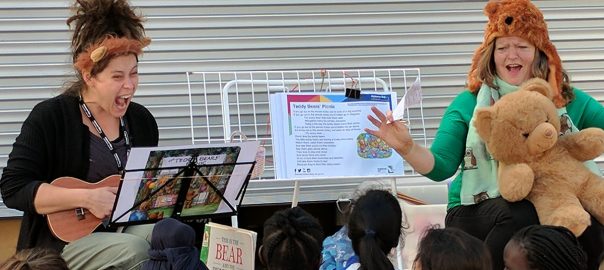This page contains a sample library storytime structure, both for an individual session, and for the year’s arc. It then contains a starter-selection (s, a, t, i, p, n) of downloadable, storytime-ready PowerPoint presentations with embedded media/songs/rhymes, book recommendations, activity printables, parent handouts, facilitator instructions, and more. From this sample, you will hopefully learn tips and tricks to construct your own tailor-made year’s arc, built to your strengths as a facilitator, and empowered by evidence-based tools and strategies.
As the State Library of Victoria and the Public Libraries Victoria Network remind us, in the Early Years Literacy Toolkit (Module 1: Planning Your Early Childhood Session, p.5):
“All early years services and programs developed by Victorian public libraries should be underpinned by the industry-agreed, stakeholder-endorsed quality standards set out in Reading and literacy for all: Quality indicators for early years literacy programs in Victorian public libraries, which is available at www.slv.vic.gov.au/read-program.
These standards are:
EY1 Sound educational underpinning [this resource is a must read]
EY2 Fun and enjoyable for all participants
EY3 Model effective reading behaviours to children and their family members or carers
EY4 Competent, passionate presenters
EY5 Inspire a love of reading and words
EY6 Target and involve both children and their family members or carers
EY7 Story-based
EY8 Facilitate access to library collections and services
EY9 Complement other early years services
EY10 Effective evaluation processes
EY11 Respond appropriately to local needs and conditions.”
The storytime professional development webpage you are currently reading seeks to share with other librarians my approach, developed over seven years’ practice, precisely to honour the values and science of these early years quality indicators—as I hope you will see below.
Most public libraries conduct their storytimes during school terms. In 2018, there are:
- 9 weeks in term one
- 11 weeks in term two
- 10 weeks in term three
- 11 weeks in term four
This equals a total of 41 weeks. There are 42 speech sounds covered in the Jolly Phonics program, and some are “doubled up”, or grouped together in the one mnemonic concept (like the cuckoo clock for both oo as in book/oo as in boom, or the donkey for ee and or), meaning that the number of weeks is an almost perfect match for the number of Jolly Songs/actions. For the highest level of evidence based literacy benefit, I approach my storytime structure from the foundation of a “sound of the week” (note that it is not a letter of the week—there are only 26 of those, and that’s not enough weeks!). From that springboard, I can then apply all of our other levels of pedagogy—whole-language engagement, behaviour and skill modelling, motor skills development, STEAM stimulation (see p.15) including basic numeracy, sequence, cause and effect, etc.
Recommended Structure
-
- Sing a regular hello song.
- Introduce the sound of the week.
- Describe the Jolly Song scenario, bringing it alive where possible with sensory experiences (puppets, toys, household objects, etc).
- Sing the Jolly Song, with actions, for this week’s sound.
- Sing the pencil grip song (“Let’s Do Some Writing”—contained in PowerPoint below), and then practice drawing “pictures” (graphemes) of the speech sound (phoneme) in the air.
- Focus book: read the first picture book selection, which is linked to the sound of the week’s theme.
- Sing two songs, linked to either the theme or, in some other way, to the previous book—or choose one song and one reading game.
- Read the second book, which can be linked to the overall theme, or segued from the immediately proceeding activity or song.
- Sing two songs, related to the overall theme or the previous book—or sing a song and play a reading game.
- Read the third and final book, linked to the theme, or previous song/game. It should be the shortest and/or least challenging book.
- Revise letter formation and Jolly Song.
- Craft and Jolly Phonics letter tracing/colour-ins.
The reason I emphasise segues, or relationships between the parts, is that we know how much story aids memory. Like an episode of Play School, give your session an arc, with meaningful relationships between the parts, so that you’re taking the kids on an imaginative adventure. In theatre terms, it’s all about entrances and exits!
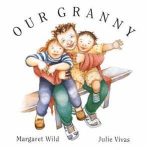 Don’t get stuck on theme, however. There’s a subtle difference between a segue focus and a theme focus. Here’s an example of what I mean: The mnemonic action for the /t/ sound in Jolly Phonics involves sounding t-t-t-t while looking left and right, as if you are watching a tennis ball go back and forth, over the net. There are not many tennis-themed preschool picture books. So in my session below, I started with Our Granny by Margaret Wild. The book lists and pictures different things grannies do to stay fit (like play tennis), the different things they wear, the different kinds of places they live, the different things they do with their grandkids, etc. I physically embodied (and encouraged them to join in where appropriate) actions, sports, etc. I engaged them conversationally to name the types of grannies from the pictures. I asked them about their own grannies, and told them about mine. I paperclipped a couple of pages together that were hard to bring alive, and which made the book run a little long for the age of my cohort. (Don’t be afraid to skip, paraphrase, discuss, or in any other ways, leverage the text for your engagement goals.)
Don’t get stuck on theme, however. There’s a subtle difference between a segue focus and a theme focus. Here’s an example of what I mean: The mnemonic action for the /t/ sound in Jolly Phonics involves sounding t-t-t-t while looking left and right, as if you are watching a tennis ball go back and forth, over the net. There are not many tennis-themed preschool picture books. So in my session below, I started with Our Granny by Margaret Wild. The book lists and pictures different things grannies do to stay fit (like play tennis), the different things they wear, the different kinds of places they live, the different things they do with their grandkids, etc. I physically embodied (and encouraged them to join in where appropriate) actions, sports, etc. I engaged them conversationally to name the types of grannies from the pictures. I asked them about their own grannies, and told them about mine. I paperclipped a couple of pages together that were hard to bring alive, and which made the book run a little long for the age of my cohort. (Don’t be afraid to skip, paraphrase, discuss, or in any other ways, leverage the text for your engagement goals.)
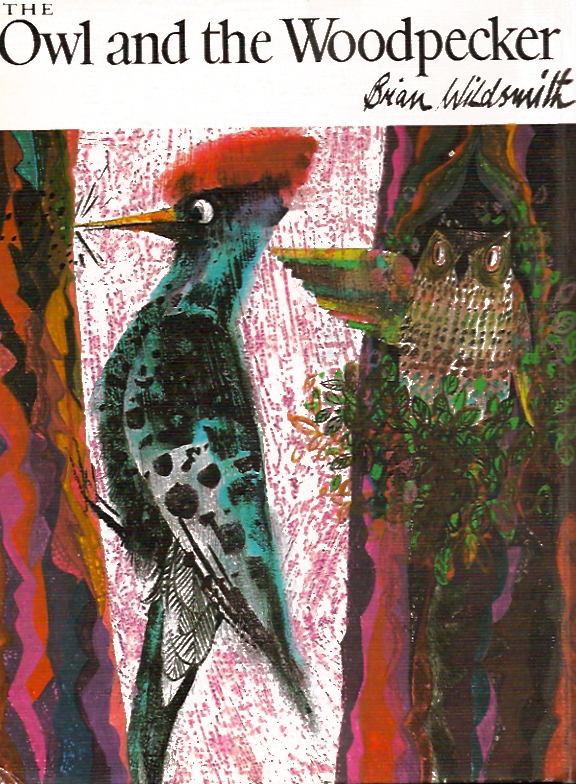 The second book segued away from the notion of t-t-t-tennis to a book about a t-t-t-tapping woodpecker. Every time the woodpecker t-t-tapped on the tree, and irritated the sleepy owl, the kids all joined in with the t-t-t action and sound. This book explores a dramatic, exploitable emotional range through the characters’ conflict, so it’s a great story to indulge with a bit of melodrama. I chatted with the kids as we went about the plot, the characters, their feelings, what you think they’re going to do, and/or where the story might be going. I also paperclipped some of this second book’s pages together, to remove an extraneous subplot that I felt would lose their attention.
The second book segued away from the notion of t-t-t-tennis to a book about a t-t-t-tapping woodpecker. Every time the woodpecker t-t-tapped on the tree, and irritated the sleepy owl, the kids all joined in with the t-t-t action and sound. This book explores a dramatic, exploitable emotional range through the characters’ conflict, so it’s a great story to indulge with a bit of melodrama. I chatted with the kids as we went about the plot, the characters, their feelings, what you think they’re going to do, and/or where the story might be going. I also paperclipped some of this second book’s pages together, to remove an extraneous subplot that I felt would lose their attention.
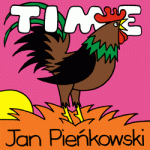 Finally, we did what might seem, at first sight, like a bad choice for a group read aloud book, but which, in fact, is a perfect example of how a simple book can be creatively brought alive: Time by Jan Pieñkowski. (Because, of course, clocks go t-t-t-t, too. Tick, tock, tick, tock.) In Time, there is a clock face with a different time on each page, along with an illustration of what people are likely to be doing at that time, like getting out of bed. Each page, the kids and I stood with our hands together, straight above our heads, at twelve o’clock. Then we physically counted with our minute-hands (their right hands, my left for mirrored modelling), ticking around like giant windmill-clocks, to arrive at the time of day currently featured in the book, eg 6am. Then we, in some way, embodied the pictures. So, for example, we yawned and stretched for getting out of bed. (A lovely bonus is to watch the empathy contagion spread around the room as everyone subconsciously yawns together!) We sang, on that page of the book, ‘I Jump Out Of Bed in the Morning’. (Don’t be afraid to interject songs—planned or unplanned—into book readings!) So, by way of this sound-of-the-week example, I deeply stress: don’t get stuck on theme. If I had insisted on picking three tennis-themed books, I would have sacrificed quality and engagement potential for arbitrary theme fidelity. Think like Play School—think in terms of segues to nearby curiosities, just like the way a child plays—and you will select better books, and you will take kids on better adventures. Remember:
Finally, we did what might seem, at first sight, like a bad choice for a group read aloud book, but which, in fact, is a perfect example of how a simple book can be creatively brought alive: Time by Jan Pieñkowski. (Because, of course, clocks go t-t-t-t, too. Tick, tock, tick, tock.) In Time, there is a clock face with a different time on each page, along with an illustration of what people are likely to be doing at that time, like getting out of bed. Each page, the kids and I stood with our hands together, straight above our heads, at twelve o’clock. Then we physically counted with our minute-hands (their right hands, my left for mirrored modelling), ticking around like giant windmill-clocks, to arrive at the time of day currently featured in the book, eg 6am. Then we, in some way, embodied the pictures. So, for example, we yawned and stretched for getting out of bed. (A lovely bonus is to watch the empathy contagion spread around the room as everyone subconsciously yawns together!) We sang, on that page of the book, ‘I Jump Out Of Bed in the Morning’. (Don’t be afraid to interject songs—planned or unplanned—into book readings!) So, by way of this sound-of-the-week example, I deeply stress: don’t get stuck on theme. If I had insisted on picking three tennis-themed books, I would have sacrificed quality and engagement potential for arbitrary theme fidelity. Think like Play School—think in terms of segues to nearby curiosities, just like the way a child plays—and you will select better books, and you will take kids on better adventures. Remember:
“The selection of books to read to young children matters enormously in the role books play for enriching children’s lives. This paper reviews the scientific evidence for the appropriate selection of books, and argues that care in selecting books targeted to children’s developing skills will enhance the power and the pleasures of reading to young children.”
“Selecting Books for Children Birth Through Four: A Developmental Approach” by Susan B. Neuman, Early Childhood Education Journal, , Volume 35, Issue 6, pp 489–494.
See also the Library Early Years Programs: The Continuum page on this site for a range of resources about children’s developmental milestones.
Storytime PowerPoint Presentations
Including Songs, Books, Games, Instructions, Handouts, Etc
The documents for download, below, contain two presentations in one. The customer-facing presentation, which will display when you click to play the slideshow. And the facilitator presentation, which explains the choices and background—these slides are hidden, and only visible in edit screens. Even if you don’t use PowerPoint in your sessions, you can print this presentation as a six-slides-to-a-page running sheet (make sure you tick “print hidden slides”), and it will offer you helpful cheats like lyrics and guitar chords.
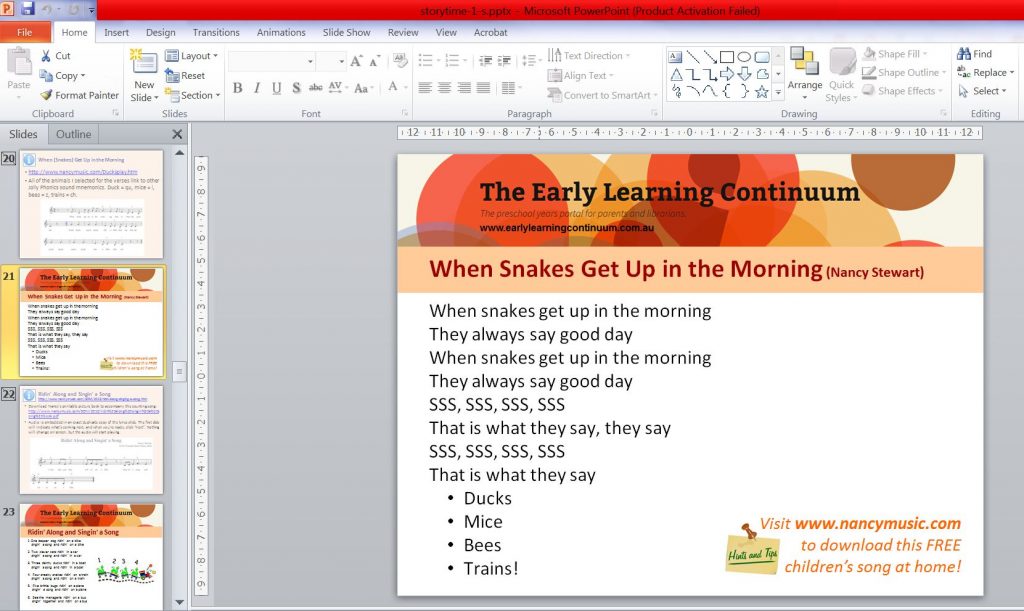
- Download the Library Storytime PowerPoint for /s/ (PPT 6.47 MB)
-
- Sing Hello, My Friends, Hello.
- Introduce the sound of the week: sss as in snake.
- Give children a visceral experience of the sss sound/snake concept. Use toys, puppets, rope, a stuffed stocking leg, or a blanket/cloth rolled up into a long sausage.
- Sing the Jolly Song, “The Snake is in the Grass”.
- Sing the pencil grip song (“Let’s Do Some Writing”), and then practice drawing “pictures” of the letter s in the air.
- Focus book: The Snake and the Boy.
- ‘Sing When Snakes Get Up In The Morning’ and ‘Ridin’ Along and Singin’ a Song’.
- Read It’s Not Just a Blanket.
- Play the Reading Game, How Many Sounds In…?, and sing ‘Zoom Zoom Zoom’.
- Read Who Am I?: Yoga for Children of All Ages.
- Revise letter formation and Jolly Song for s.
- Hand out spiral snake craft and Jolly Phonics letter tracing/colour-ins.
-
- Download the Library Storytime PowerPoint for /a/ (PPT 00 MB)
- Download the Library Storytime PowerPoint for /t/ (PPT 12.6 MB)
